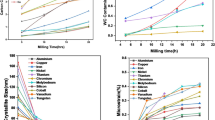Abstract
This work is devoted to the preparation of powders of Ti2AlC and Ti3AlC2 MAX phases by self-propagating high-temperature synthesis (SHS) using the magnesium-thermal reduction from oxide feedstock. Oxide TiO2 is used as the titanium source, and magnesium is used as the reducing agent. Purification with the removal of magnesium oxide is performed in diluted hydrochloric acid at a temperature of 70°C and concentration of 1 : 3. The target product yield with the magnesium-thermal reduction is 35–40%. It is revealed that the synthesis product with the stoichiometric component ratio after chemical leaching in hydrochloric acid consists of Ti2AlC, MgAl2O4, and TiC. The formation of spinel MgAl2O4 is associated with the deficiency of the magnesium reducing agent in the charge; herewith, aluminum partially enters the reduction reaction of titanium from its oxide with the formation of Al2O3. This leads to the formation of spinel MgO ⋅ Al2O3. An increase in the content of excess magnesium in the charge from 20 to 30 wt % conditions the complete reduction of titanium from its oxide by magnesium with the formation of the Ti2AlC MAX phase and titanium carbide. A decrease of 10 wt % in the carbon content causes a decrease in the titanium carbide fraction to 4%. The product, containing Ti3AlC2 and Ti2AlC MAX phases, as well as TiC, is formed at an excess soot content from 20 to 35%, and the Ti3AlC2 weight fraction increases from 86 to 89%, respectively. These powders comprise agglomerates (87% of them are smaller than 65 μm) consisting of thin plates of MAX phases 70–100 nm in thickness.



Similar content being viewed by others
REFERENCES
Barsoum, M.W., MAX Phases: Properties of Machinable Ternary Carbides and Nitrides, Wiley-VCH, 2013.
Barsoum, M.W., Bridkin, D., and Raghy, T.E., Layered machinable ceramics for high temperature applications, Scr. Metall. Mater., 1997, vol. 36, pp. 535–539.
Barsoum, M.W., The Mn+1AXn phases: A new class of solids, Prog. Solid State Chem., 2000, vol. 28, pp. 201–281.
Radovic, M. and Barsoum, M.W., MAX phases: Bridging the gap between metals and ceramics, Am. Ceram. Soc. Bull., 2013, vol. 92, no. 3, pp. 20–27.
Rahman, A. and Rahaman, Z., Study on structural, electronic, optical and mechanical properties of MAX phase compounds and applications, Am. J. Mod. Phys., 2015, vol. 4, no. 2, pp. 75–91.
Tallman, D.J., Anasori, B., and Barsoum, M.W., A critical review of the oxidation of Ti2AlC, Ti3AlC2 and Cr2AlC in air, Mater. Res. Lett., 2013, vol. 1, pp. 115–125.
Poon, B., Ponson, L., Zhao, J., and Ravichandran, G., Damage accumulation and hysteretic behavior of MAX phase materials, J. Mech. Phys. Solids, 2011, vol. 59, pp. 2238–2257.
Zhang, H.B., Bao, Y.W., and Zhou, Y.C., Current status in layered ternary carbide Ti3SiC2: A review, J. Mater. Sci. Technol., 2009, vol. 25, no. 1, pp. 1–38.
Barsoum, M.W., Ali, M., and El-Raghy, T., Processing and characterization of Ti2AlC, Ti2AlN, and Ti2AlC0.5N0.5, Metall. Mater. Trans. A, 2000, vol. 31, pp. 1857–1863.
Yan, M., Chen, Y., Mei, B., and Zhu, J., Synthesis of high-purity Ti2AlN ceramic by hot pressing, Trans. Nonferrous Met. Soc. China, 2008, vol. 18, no. 1, pp. 82–85.
Luginina, M.A., Kovalev, D.Yu., and Sytschev, A.E., Preparation of Ti2AlN by reactive sintering, Int. J. Self-Propag. High-Temp. Synth., 2016, vol. 25, no. 1, pp. 35–38.
Hong Xiao-lin, Mei Bing-chu, Zhu Jiao-qun, and Zhou Wei-bing, Fabrication of Ti2AlC by hot pressing of Ti, TiC, Al and active carbon powder mixtures, J. Mater. Sci., 2004, vol. 39, no. 5, pp. 1589–1592.
Zhou, W.B., Mei, B.C., Zhu, J.Q., and Hong, X.L., Rapid synthesis of Ti2AlC by spark plasma sintering technique, Mater. Lett., 2005, vol. 5, pp. 131–139.
Liu, Y., Shi, Zh., Wang, J., Qiao, G., Jin, Zh., and Shen, Zh., Reactive consolidation of layered-ternary Ti2AlN ceramics by spark plasma sintering of a Ti/AlN powder mixture, J. Eur. Ceram. Soc., 2011, vol. 31, no. 5, pp. 863–868.
Levashov, E.A., Pogozhev, Y.S., Shtansky, D.V., and Petrzhik, M.I., Self-propagating high-temperature synthesis of ceramic materials based on the MAX phases in the Ti–Cr–Al–C system, Russ. J. Non-Ferrous Met., 2009, vol. 50, no. 2, pp. 151–159.
Hendaoui, A., Andasmas, M., Benaldjia, A., Langlois, P., and Vrel, D., SHS of high-purity MAX compounds in the Ti–Al–C system, Int. J. Self-Propag. High-Temp. Synth., 2008, vol. 17, no. 2, pp. 129–136.
Vadchenko, S.G., Sytschev, A.E., Kovalev, D.Yu., Shukin, A.S., and Belikova, A.F., SHS of MAX compounds in the Ti-Si-C system: influence of mechanical activation, Int. J. Self-Propag. High-Temp. Synth., 2014, vol. 23, no. 3, pp. 141–144.
Thomas, T. and Bowen, C., Effect of particle size on the formation of Ti2AlC using combustion synthesis, Ceram. Int., 2016, vol. 42, pp. 4150–4157.
Bazhin, P.M., Kovalev, D.Yu., Luginina, M.A., and Averichev, O.A., Combustion of Ti–Al–C compacts in air and helium: A TRXRD study, Int. J. Self-Propag. High-Temp. Synth., 2016, vol. 25, no. 1, pp. 30–34.
Bai, Y., He, X., Li, Y., Zhu, C., and Zhang, S., Rapid synthesis of bulk Ti2AlC by self-propagating high temperature combustion synthesis with a pseudo-hot isostatic pressing process, J. Mater. Res., 2009, vol. 24, no. 8, pp. 2528–2535. https://doi.org/10.1557/jmr.2009.0327
Yeh, C.L., Kuo, C.W., and Chu, Y.C., Formation of Ti3AlC2/Al2O3 and Ti2AlC/Al2O3 composites by combustion synthesis inTi–Al–C–TiO2 systems, J. Alloys Compd., 2010, vol. 494, pp. 132–136.
Author information
Authors and Affiliations
Corresponding authors
About this article
Cite this article
Vershinnikov, V.I., Kovalev, D.Y. Preparation of Ti2AlC and Ti3AlC2 MAX Phases by Self-Propagating High-Temperature Synthesis with the Reduction Stage. Russ. J. Non-ferrous Metals 61, 554–558 (2020). https://doi.org/10.3103/S1067821220050156
Received:
Revised:
Accepted:
Published:
Issue Date:
DOI: https://doi.org/10.3103/S1067821220050156




